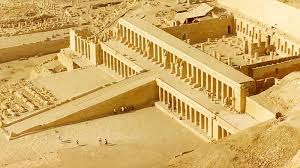Hello Friends, Welcome back to another blog. In this blog, I explain the History of the Temple of Hatshepsut.
The Temple of Hatshepsut, also known as Djeser-Djeseru,
stands as a testament to the remarkable reign of Queen Hatshepsut, one of
ancient Egypt's most intriguing figures. Situated on the west bank of the Nile
River near Luxor, Egypt, this mortuary temple is a masterpiece of ancient
Egyptian architecture, blending seamlessly with the surrounding cliffs of the
Valley of the Kings. In this narrative, we journey through time to
explore the rich history, significance, and legacy of the Temple of Hatshepsut.
1. The Rise of Hatshepsut:
Our story begins in the 15th century BCE, during the New
Kingdom period of ancient Egypt. Hatshepsut was born into the royal family
during the reign of her father, Thutmose I. Little did anyone know then that
she would become one of Egypt's most iconic rulers. As a young woman,
Hatshepsut married her half-brother, Thutmose II, who ascended to the throne
after the death of their father.
2. Hatshepsut's Unconventional Reign
Upon the death of her husband, Thutmose II, Hatshepsut
assumed the role of regent for her stepson, Thutmose III, who was still a
child. However, instead of relinquishing power when Thutmose III came of age,
Hatshepsut took the unprecedented step of declaring herself pharaoh, becoming
one of the few female rulers in ancient Egyptian history. To legitimize her
rule, she claimed divine birth, asserting that the god Amun had chosen her as
his daughter and heir.
3. The Vision of Djeser-Djeseru
With her reign secure, Hatshepsut set about establishing her
legacy through ambitious building projects, none more grandiose than the Temple
of Hatshepsut. Designed by the architect Senenmut, the temple was conceived as
a mortuary complex dedicated to the worship of Amun-Ra, the chief deity of the
Egyptian pantheon, and to commemorate the life and achievements of Hatshepsut
herself. Its location at Deir el-Bahari, nestled against the cliffs of the
Theban Necropolis, was carefully chosen to symbolize the transition from the
earthly realm to the afterlife.
4. Architecture and Design
The Temple of Hatshepsut is renowned for its innovative
architecture and harmonious integration with the natural landscape. The
structure consists of three terraced levels, each connected by ramps and
adorned with colonnades, statues, and reliefs. The lower terrace features a
large courtyard surrounded by columns, while the middle terrace contains
chapels dedicated to various gods, including Anubis and Hathor. The upper
terrace, accessed via a grand staircase, houses the primary sanctuary and the
iconic Hathor-headed columns, evoking the goddess associated with music, love,
and motherhood.
5. Commemorating a Pharaoh
Throughout the temple complex, intricate reliefs and
hieroglyphic inscriptions depict scenes from Hatshepsut's life, including her
divine birth, ceremonial offerings to the gods, and military expeditions to the
land of Punt. These inscriptions serve not only as historical records but also
as propaganda, legitimizing Hatshepsut's rule and reinforcing her divine
status. However, following her death, many of these inscriptions were defaced
or destroyed by her successor, Thutmose III, in an attempt to erase her memory
from history.
6. Rediscovery and Restoration
For centuries, the Temple of Hatshepsut lay buried beneath
the sands of Egypt, its splendor obscured by time and neglect. It was not until
the 19th century that the temple was rediscovered by archaeologists, who
marveled at its beauty and significance. Despite the damage inflicted by
Thutmose III and the ravages of time, extensive restoration efforts have
ensured that the temple remains a marvel of ancient engineering and a testament
to Hatshepsut's enduring legacy.
7. Legacy and Significance
Today, the Temple of Hatshepsut symbolizes female
empowerment and royal authority in ancient Egypt. It serves as a reminder of
Hatshepsut's remarkable reign and her contributions to art, architecture, and
culture. Moreover, the temple's enduring popularity as a tourist attraction
highlights its significance as a UNESCO World Heritage Site and a window into
the splendor of ancient Egyptian civilization.
In conclusion, the Temple of Hatshepsut stands as a
testament to the ingenuity, ambition, and legacy of one of ancient Egypt's most
remarkable rulers. Through its stunning architecture, intricate reliefs, and
timeless beauty, the temple continues to inspire awe and admiration, inviting
visitors to embark on a journey through the annals of history and experience
the grandeur of the pharaohs.

.jpeg)
.jpg)
.jpeg)
Comments
Post a Comment